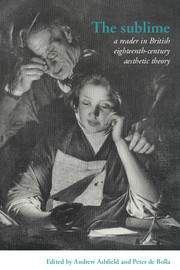Book contents
- Frontmatter
- Contents
- List of Abbreviations
- Introduction
- Part I The Longinian tradition
- Part II Rhapsody to rhetoric
- Part III Irish Perspectives
- Part IV The Aberdonian Enlightenment
- Part V Edinburgh and Glasgow
- 34 A treatise of human nature (1739-40)
- 35 A critical dissertation on the poems of Ossian (1763)
- 36 Lectures on rhetoric and belles lettres (1783)
- 37 Elements of criticism (1765)
- 38 Essays on philosophical subjects (1758/1795)
- 39 The theory of moral sentiments (1759/1790)
- 40 An essay on the history of civil society (1767)
- Part VI From the Picturesque to the Political
- Sources and further reading
40 - An essay on the history of civil society (1767)
Published online by Cambridge University Press: 05 June 2012
- Frontmatter
- Contents
- List of Abbreviations
- Introduction
- Part I The Longinian tradition
- Part II Rhapsody to rhetoric
- Part III Irish Perspectives
- Part IV The Aberdonian Enlightenment
- Part V Edinburgh and Glasgow
- 34 A treatise of human nature (1739-40)
- 35 A critical dissertation on the poems of Ossian (1763)
- 36 Lectures on rhetoric and belles lettres (1783)
- 37 Elements of criticism (1765)
- 38 Essays on philosophical subjects (1758/1795)
- 39 The theory of moral sentiments (1759/1790)
- 40 An essay on the history of civil society (1767)
- Part VI From the Picturesque to the Political
- Sources and further reading
Summary
Part First. Of the general characteristics of human nature
Section I. Of the questions relating to the state of nature
… We speak of art as distinguished from nature; but art itself is natural to man. He is in some measure the artificer of his own frame, as well as his fortune, and is destined, from the first age of his being, to invent and contrive. He applies the same talents to a variety of purposes, and acts nearly the same part in very different scenes. He would be always improving on his subject, and he carries this intention wherever he moves, through the streets of the populous city, or the wilds of the forest. While he appears equally fitted to every condition, he is upon this account unable to settle in any. At once obstinate and fickle, he complains of innovations, and is never sated with novelty. He is perpetually busied in reformations, and is continually wedded to his errors. If he dwell in a cave, he would improve it into a cottage; if he has already built, he would still build to a greater extent. But he does not propose to make rapid and hasty transitions; his steps are progressive and slow; and his force, like the power of a spring, silently presses on every resistance; and effect is sometimes produced before the cause is perceived; and with all his talent for projects, his work is often accomplished before the plan is devised.
- Type
- Chapter
- Information
- The SublimeA Reader in British Eighteenth-Century Aesthetic Theory, pp. 253 - 262Publisher: Cambridge University PressPrint publication year: 1996
- 17
- Cited by

